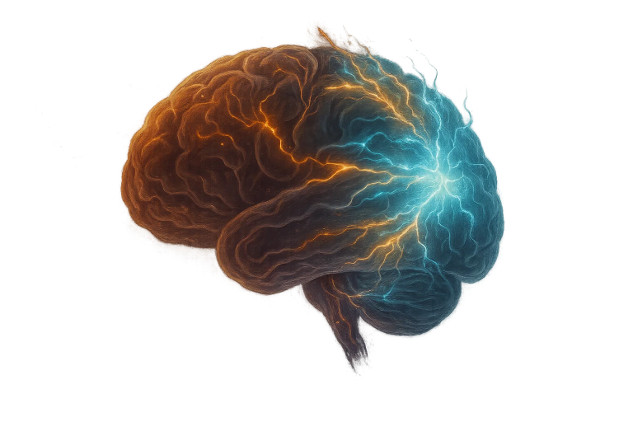
In This Article
- What is cognitive control, and why does it matter in anxiety?
- Why does your brain flip between proactive and reactive control?
- Can mindfulness actually rewire how your mind processes fear and worry?
- What’s the difference between focused attention and open monitoring?
- How can we apply these insights to real-world anxiety treatment?
Mindfulness Is Brain Rewiring for the Anxious Masses
by Robert Jennings, InnerSelf.comSuppose you’ve ever had a brain freeze in the middle of a panic attack or gone completely blank during a job interview. In that case, you’ve experienced what happens when your cognitive control system takes a backseat. Mental control is like the mind’s air traffic controller—it decides what gets your attention, what gets ignored, and how to respond when things get overwhelming. It’s the mental mechanism that lets you focus on a task despite distractions, suppress impulsive reactions, and plan your next move with clarity. Ideally, it runs the show smoothly. But when anxiety creeps in, that system starts glitching.
Anxiety, a rule-breaker that barges into your thoughts uninvited, can disrupt your mental control. It redirects your focus to perceived threats, amplifies worst-case scenarios, and replaces logic with raw emotion. Suddenly, your ability to prioritize or stay present vanishes. You’re no longer in the driver's seat—fear is. This is where mindfulness steps in, not as a spiritual escape, but as a form of mental resistance training. It fortifies the very control systems that anxiety loves to disrupt, helping you steer your focus back where it belongs, even in the midst of the storm.
Proactive vs Reactive: Your Brain’s Tug-of-War
Imagine two modes of control in your brain. In proactive control, your brain prepares for trouble before it shows up—like locking your doors before bedtime. Reactive control, on the other hand, waits until the burglar is already inside. Anxiety tends to mess with this balance. Chronic worry eats up mental resources, leaving little room for planning ahead. And when fear spikes, the brain scrambles into reactive mode. Studies show that high-anxiety individuals often rely too heavily on reactive control—constantly putting out fires rather than preventing them.
Forget the incense and lotus positions for a moment. Mindfulness—at its core—is training your mind to stay present without judgment. That might sound soft, but it turns out it’s closer to mental CrossFit. Regular practice strengthens neural circuits associated with attention, emotional regulation, and—surprisingly—cognitive control. Functional MRI scans show enhanced connectivity in the brain's frontoparietal network after sustained mindfulness training. Translation? Your brain gets better at switching gears, focusing on tasks, and staying calm under pressure.
Not All Anxiety Is Created Equal
Here’s where it gets interesting—because, surprise, anxiety isn’t a one-size-fits-all monster lurking in your mind. The latest research categorizes it into different types of mental chaos. There’s trait anxiety, the kind that lingers like background noise, shaping how you perceive the world every day. Then there’s state anxiety, those intense, short-lived bursts of nervous energy that hit you before a job interview, a big test, or any high-stakes situation. Beyond that, we’ve got two distinct styles of anxious response: anxious apprehension, which is rooted in chronic, spiraling worry, and anxious arousal, which shows up as physical panic, heart-racing fear, and fight-or-flight responses. These aren’t just labels—they’re linked to different brain pathways and processes.
So why should you care about the labels? Because if anxiety isn’t one-size-fits-all, then neither should the tools we use to manage it. Picture going to a mechanic who gives every broken car the same fix regardless of the problem—it doesn’t sound too bright, right? The same goes for your brain. Mindfulness, while powerful, isn’t a universal solution unless it’s applied with precision. A person plagued by constant worry may benefit from a completely different mindfulness approach than someone who’s hit with sudden panic attacks. This isn’t about making mindfulness more complicated—it’s about making it more effective by tailoring it to the specific brand of anxiety that’s hijacking your mind.
Two Paths to Presence: FA vs OM
Focused Attention (FA) and Open Monitoring (OM) are like the yin and yang of mindfulness—complementary practices that work on different levels of mental function. FA is the more structured of the two. It’s all about locking your attention onto a single anchor, usually something steady and straightforward like your breath, a sound, or even a candle flame. By practicing FA, you're training your brain to stay proactive—to anticipate distractions before they grab hold and to maintain a clear mental trajectory. This kind of attention sharpening builds up your proactive control, helping you stay ahead of spiraling thoughts instead of getting swept away by them. For people who struggle with chronic worry or obsessive thinking, FA can be a mental lifesaver, building the muscle needed to intercept anxiety before it gains momentum.
Open Monitoring (OM), on the other hand, adopts a more lenient and expansive approach. Instead of focusing narrowly, OM encourages you to notice everything that arises—thoughts, sensations, emotions—without clinging to or resisting any of it. It’s mindfulness without a steering wheel, allowing you to observe your internal experience as it unfolds, moment by moment. This practice strengthens reactive control, teaching your mind to respond calmly and without panic when the unexpected occurs. For those who experience anxiety as sudden waves of fear, physical tension, or sensory overload, OM provides a way to stay afloat. It doesn't try to stop the wave; it teaches you how to surf it. Together, FA and OM offer an adaptable toolkit, allowing mindfulness to meet anxiety where it lives—in all its unpredictable, multifaceted forms.
This Isn’t Just Science—It’s Strategy
According to the latest neuroscience review, what we’ve lacked is precision. Mindfulness and anxiety have been studied like blunt instruments. However, when you break down these concepts into their components—FA vs. OM, proactive vs. reactive control, and anxious apprehension vs. arousal—a new map emerges. The proposal? Align the type of mindfulness training with the kind of anxiety and the specific control deficit. Then, test it using behavioral and neural metrics, such as EEG or fMRI. It’s a framework for personalized mental training—not woo-woo generality.
Let’s be clear: this isn’t about making mindfulness trendy. It’s about using science to finally understand why some people panic. In contrast, others plan how to retrain our mental operating systems. Picture a world where your therapist doesn’t just hand you a meditation app but prescribes a specific type of mindfulness-based on your cognitive control profile. Or better yet, you train yourself—mindfully, strategically—to manage your mental terrain.
The Real Revolution: Tailored Mental Fitness
What’s revolutionary here isn’t mindfulness itself—it’s the radical rethinking of what anxiety actually is. For too long, we've treated anxiety like a singular, shadowy villain lurking in the brain, as if one strategy or medication could shut it down across the board. But the truth is, anxiety operates more like an ecosystem—a tangled web of traits, states, responses, and brain circuits that all interact differently depending on the situation and the person. Recognizing this complexity is not just an academic insight; it fundamentally reshapes how we approach mental health. It invites a new kind of precision in care, one that acknowledges that not all minds respond to panic in the same way and that not all paths to calm require the same map.
Even more transformative is the realization that at the heart of anxiety lies a battle for attention—where it goes, how it’s managed, and whether it serves you or sabotages you. Proactive and reactive control aren’t just academic terms; they are the levers that determine whether your thoughts run wild or stay grounded. And mindfulness, when used strategically, isn’t about zoning out or lighting incense—it’s about tuning in and taking the wheel. It provides you with the tools to intervene in real time, redirect, reframe, and regain mental control. In that sense, the goal isn’t just peace of mind—it’s a more intelligent, more adaptable mind. We’re not calming the mind so it can rest; we’re upgrading it so it can thrive.
About the Author
 Robert Jennings is the co-publisher of InnerSelf.com, a platform dedicated to empowering individuals and fostering a more connected, equitable world. A veteran of the U.S. Marine Corps and the U.S. Army, Robert draws on his diverse life experiences, from working in real estate and construction to building InnerSelf with his wife, Marie T. Russell, to bring a practical, grounded perspective to life’s challenges. Founded in 1996, InnerSelf.com shares insights to help people make informed, meaningful choices for themselves and the planet. More than 30 years later, InnerSelf continues to inspire clarity and empowerment.
Robert Jennings is the co-publisher of InnerSelf.com, a platform dedicated to empowering individuals and fostering a more connected, equitable world. A veteran of the U.S. Marine Corps and the U.S. Army, Robert draws on his diverse life experiences, from working in real estate and construction to building InnerSelf with his wife, Marie T. Russell, to bring a practical, grounded perspective to life’s challenges. Founded in 1996, InnerSelf.com shares insights to help people make informed, meaningful choices for themselves and the planet. More than 30 years later, InnerSelf continues to inspire clarity and empowerment.
Creative Commons 4.0
This article is licensed under a Creative Commons Attribution-Share Alike 4.0 License. Attribute the author Robert Jennings, InnerSelf.com. Link back to the article This article originally appeared on InnerSelf.com
books_mindfulness
Article Recap
This article unpacks how mindfulness improves cognitive control—specifically proactive and reactive modes—and how different mindfulness techniques may help with distinct anxiety dimensions. By tailoring mindfulness practice to fit the kind of anxiety we face, we can develop a sharper, science-backed mental toolkit for daily resilience.
References
- Resh S. Gupta,, Wendy Heller , Todd S. Braver Reconceptualizing the relationship between anxiety, mindfulness, and cognitive control https://pdf.sciencedirectassets.com/271127/1-s2.0-S0149763425X00051/1-s2.0-S0149763425001460/main.pdf
- Creswell, J. D. (2017). Mindfulness Interventions. Annual Review of Psychology, 68(1), 491–516.
https://doi.org/10.1146/annurev-psych-042716-051139 - Tang, Y.-Y., Hölzel, B. K., & Posner, M. I. (2015). The neuroscience of mindfulness meditation. Nature Reviews Neuroscience, 16, 213–225.
https://doi.org/10.1038/nrn3916 - Miller, E. K., & Cohen, J. D. (2001). An integrative theory of prefrontal cortex function. Annual Review of Neuroscience, 24, 167–202.
https://doi.org/10.1146/annurev.neuro.24.1.167 - Bishop, S. R., Lau, M., Shapiro, S., et al. (2004). Mindfulness: A proposed operational definition. Clinical Psychology: Science and Practice, 11(3), 230–241.
https://doi.org/10.1093/clipsy.bph077 - Etkin, A., Büchel, C., & Gross, J. J. (2015). The neural bases of emotion regulation. Nature Reviews Neuroscience, 16(11), 693–700.
https://doi.org/10.1038/nrn4044 - Fox, K. C. R., et al. (2016). Functional neuroanatomy of meditation: A review and meta-analysis of 78 functional neuroimaging investigations. Neuroscience & Biobehavioral Reviews, 65, 208–228.
https://doi.org/10.1016/j.neubiorev.2016.03.021 - Keng, S.-L., Smoski, M. J., & Robins, C. J. (2011). Effects of mindfulness on psychological health: A review of empirical studies. Clinical Psychology Review, 31(6), 1041–1056.
https://doi.org/10.1016/j.cpr.2011.04.006
#Mindfulness #CognitiveControl #AnxietyRelief #ProactiveControl #Neuroscience #MentalHealth



